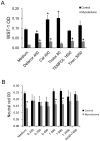Antioxidants protect keratinocytes against M. ulcerans mycolactone cytotoxicity
- PMID: 21079804
- PMCID: PMC2973957
- DOI: 10.1371/journal.pone.0013839
Antioxidants protect keratinocytes against M. ulcerans mycolactone cytotoxicity
Abstract
Background: Mycobacterium ulcerans is the causative agent of necrotizing skin ulcerations in distinctive geographical areas. M. ulcerans produces a macrolide toxin, mycolactone, which has been identified as an important virulence factor in ulcer formation. Mycolactone is cytotoxic to fibroblasts and adipocytes in vitro and has modulating activity on immune cell functions. The effect of mycolactone on keratinocytes has not been reported previously and the mechanism of mycolactone toxicity is presently unknown. Many other macrolide substances have cytotoxic and immunosuppressive activities and mediate some of their effects via production of reactive oxygen species (ROS). We have studied the effect of mycolactone in vitro on human keratinocytes--key cells in wound healing--and tested the hypothesis that the cytotoxic effect of mycolactone is mediated by ROS.
Methodology/principal findings: The effect of mycolactone on primary skin keratinocyte growth and cell numbers was investigated in serum free growth medium in the presence of different antioxidants. A concentration and time dependent reduction in keratinocyte cell numbers was observed after exposure to mycolactone. Several different antioxidants inhibited this effect partly. The ROS inhibiting substance deferoxamine, which acts via chelation of Fe(2+), completely prevented mycolactone mediated cytotoxicity.
Conclusions/significance: This study demonstrates that mycolactone mediated cytotoxicity can be inhibited by deferoxamine, suggesting a role of iron and ROS in mycolactone induced cytotoxicity of keratinocytes. The data provide a basis for the understanding of Buruli ulcer pathology and the development of improved therapies for this disease.
Conflict of interest statement
Figures



References
-
- George KM, Chatterjee D, Gunawardana G, Welty D, Hayman J, et al. Mycolactone: a polyketide toxin from Mycobacterium ulcerans required for virulence. Science. 1999;283:854–857. - PubMed
-
- Adusumilli S, Mve-Obiang A, Sparer T, Meyers W, Hayman J, et al. Mycobacterium ulcerans toxic macrolide, mycolactone modulates the host immune response and cellular location of M. ulcerans in vitro and in vivo. Cell Microbiol. 2005;7:1295–1304. - PubMed
MeSH terms
Substances
LinkOut - more resources
Full Text Sources
Other Literature Sources
Medical

